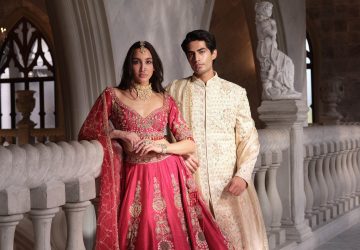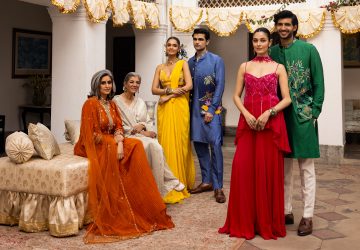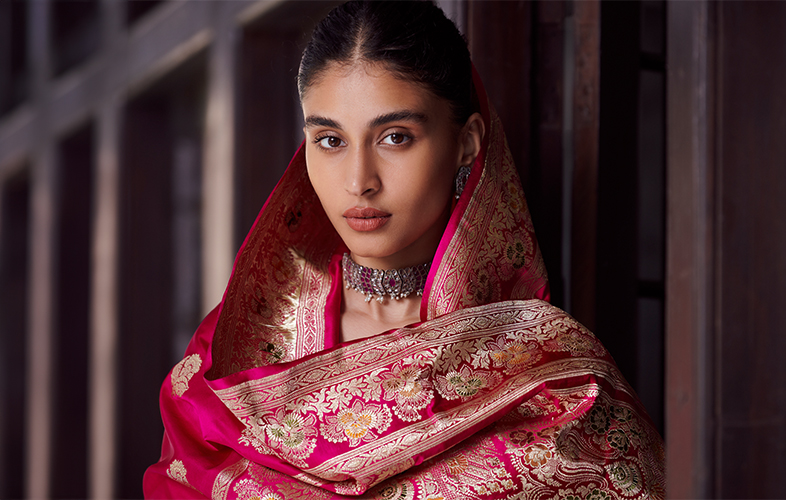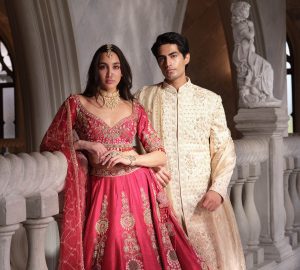The patola or the double ikkat weave, the pride of Gujarat, marries the technique of tying, dyeing, and weaving. It is an exquisite art form tracing back over 700 years.
The patola weave is steeped in history and even found in Ajanta Caves’ carvings! The patola silk weave is popular in Central Asia and Southeast Asia, and although there are many forms of ikkat, the patola weave by far is the most exquisite. No wonder, the pure patola silk sarees and salwar suits are considered priceless and beautiful pieces of handloom.
Not only that, it takes the prowess of four weavers and more than six months to achieve weaving perfection. The dyeing process is a combination of a unique process that involves careful calculation and vivid imagination. The double ikkat weave lends the same feel and texture on both sides, even the color and the intensity are the same.
If you are charmed by the spectacular weaving technique, stay tuned as we will find you the best ensembles like the patola saree that you can wear with pride at festivals and weddings.


Origins of Patola Weaving
Patola comes from the Sanskrit word ‘pattakulla’, meaning silk fabric. The patola craft can be traced 11 centuries back, when the Salvi Community, all 700 of them moved from Maharashtra and Karnataka under the Solanki Dynasty, to Patan, Gujarat. It was King Kumarpala’s love for the exquisite fabric that resulted in the exodus of the weavers. King Kumarpala was so enamored by it that he wore a new patola every day on his way to the temple.
Patan patola holds a key position in the cultural heritage of India. With its vibrant hues, intricate designs, and exquisite craftsmanship it is synonymous with the very world of luxury. The making of the Patan patola involves a labor-intensive process that involves immense skill and precision.


Iconic Patola Designs
The original patola weaves had traditional prints such as human figures, elephants, flowers, kalash, paan, shikhar, parrots, and architectural designs inspired by the architecture of Gujarat. However, modern designers are experimenting more with the conventional and creating unique designs that are melding with the classic designs, instead of sticking out like a sore thumb.
Each of the patola silk saree designs has a unique name. Each of the symbols signifies the following things,
- Paan Bhat: It includes pan-shaped leaves with parrots, blossoming flowers, elephants, and female dancers’ symbols.
- Nari Kunjar Bhat: It includes the captivating design of floral and elephant motifs.
- Navratna Bhat: It includes unique square-shaped patterns.
- Fulvali Bhat: It includes beautiful floral designs and patterns.
- Rattanchowk Bhat: It includes exquisite geometric designs and patterns.
The classic handloom saree from the heart of KALKI fashion is an absolute vision. The special geometric patterns and designs with ikat weave and resham work include intricate floral designs and geometric patterns. With a jadau jewelry set, it can lend a premium feel to the whole ensemble and is perfect for festive and wedding occasions.


Patola Weaving Techniques
Patolas are created with a resist-dyeing process with a warp and weft technique. The process is time-consuming as takes around four to seven months to create an exquisite weave. The process involves tying the yarn with cotton threads to create a pattern. The yarn goes through several cycles of tying and dyeing, including a specific color pattern.
Every color has a specific place in the design to maintain a proper alignment. The laborious process takes around a year to make these collector’s items. The double ikat technique includes a process in which both the warp and weft threads are resist-dyed before the beginning of the weaving technique.


The Role Of Patola In Gujarat’s Culture
Patola saree has an immense cultural significance. The Indian weave is considered to be a great option for auspicious occasions and hence part of many sacred occasions. The sarees are also believed to bring good luck and ward off evils from the family and the community.
The craftsmanship of patola is only passed down to family members of the Salvis. A person or a stranger cannot ask the Patola weaver to teach him the craft.
The residents of the state of Gujarat also regard these sarees as stridhan. So, when the sarees are given to the bride during their weddings, they are regarded as properties, which are given to daughters and daughters-in-law. The incredible patterns and motifs of the weave, including lotus flowers, leaves, and buds also symbolize fertility.
Patola sarees also became a status symbol among the Gujarati people. They were also gifted to kings and priests to form good relations.
Earlier the saree or weave was only part of pious occasions. For instance, King Kumarpal only wore them at temples for special rituals. During the 15th and 16th centuries, it became popular among the Indonesians who considered it a cloth, “made by God.” Since it’s only God who can create something as majestic as this.


Patola Beyond Saris
There is no doubt that the beauty of the patola sarees is incomparable. Patola is one of the most beautiful handloom products belonging to the Indian handloom industry and has remained popular among different generations. Everyone likes a good patola saree.
However, the patola weaves are available in products other than sarees such as dupattas, stoles, men’s wear, and home decor items. So, even if you don’t wear sarees, you can always include them in your home, whether it is in the form of stoles or other products.
For years, patola has been regarded as an auspicious heirloom. It continues to be the toast of the royal and the affluent. Patola silk is also a sign of good luck. No wonder, it is hung in almost every popular textile museum because it is a prized procession. For some people it is the impeccable quality of the weave that makes it different, for a few others, it is the vibrant hues, the reasons are so many. But the truth of the matter is the weave of the patola will remain steadfast just like its ever-bright colors.


Patola Weaving Today
Patola is truly the epitome of exquisite craftsmanship. Today, only a few families, the Salvis and Sonis, are still practicing the craft in Patan. These families still don’t want to share the art and aren’t very open to forging the craft. Only the male family members are allowed to practice the craft. People outside the Salvi and Soni communities are not admitted into craftsmanship.
However, things have been changing in the past couple of years as Sonis has started including people outside the said boundaries and is passing this craft to people who are interested and dedicated to the craft. This move is to ensure that the craft does not die a slow death.
The double-ikat patola textiles were earlier woven in Patan, Surat, and a few other centers but today there are now only two families of Jians who weave patola in Patan. Cheaper forms of the original are woven in single ikat in Rajkot, Saurashtra, and Andhra Pradesh in the South. To safeguard its fading existence the Salvi community made the Patan Patola Heritage Museum in 2014 to preserve its magnificence.


The women of today need to add more such classics such as the patola silks to their closets to ensure that the age-old craft of patola weave does not die a silent death. Remember there is a reason that the patola weaves are expensive, they are priceless.
In the quest for exquisite patola silk sarees, patola dresses, or patola lehengas of impeccable quality, look no further than KALKI Fashion. With a commitment to quality and authenticity, KALKI ensures that each creation is a work of art, meticulously crafted to adorn you with elegance and charm. Embark on your journey to embrace the opulence of patola fashion by visiting KALKI’s online store at kalkifashion.com, where every piece tells a story of artistry, culture, and timeless beauty.
Also Read: Unveiling the Beauty: Step-by-Step Tutorial for Draping Athpourey Sarees
![]()








